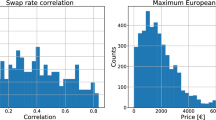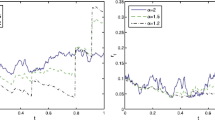Abstract
A novel methodology to investigate the fine structure of interest rates based on Machine Learning techniques is discussed. The aim is to capture in an unsupervised way the common stochastic structure that drives the dynamics of interest rates of different maturities. The proposed approach is based on the Wasserstein barycenter, a powerful tool of analysis that allows us to construct, from a set of assigned probability distributions, a single probability distribution that captures the essential features of the whole set. To identify common stochastic factors, a Gaussian Mixture Model is fitted to the Wasserstein barycenter by maximum likelihood using the Expectation-Maximization algorithm with an initialization strategy based on Graph Machine Learning techniques. A fine-tuning of single-maturity interest rates is discussed in an attempt to capture maturity-specific stochastic factors. The proposed analysis also gives us the opportunity to test the hypothesis of a market segmentation into a short-term segment, the money market, and a long-term segment, the capital market, each with its own segment-specific stochastic factors. The methodology is tested on the US zero-coupon Treasury yield curve. The results obtained seem to show that most of the stochastic nature of the dynamics of the US zero-coupon yield curve can be captured by a three-component Gaussian Mixture Model describing the Wasserstein barycenter of the short-term segment of the yield curve.








Similar content being viewed by others
Explore related subjects
Discover the latest articles, news and stories from top researchers in related subjects.Data Availability
The dataset comprising zero-coupon yields utilized in this study is openly accessible via the following URL: https://sites.google.com/view/jingcynthiawu/yield-data.
References
Gürkaynak RS, Wright JH (2012) Macroeconomics and the term structure. J Econ Lit 50(2):331–67. https://doi.org/10.1257/jel.50.2.331
Filipovic D (2009) Term-structure models: a graduate course. Springer, Springer Finance, Berlin
Dai Q, Singleton K (2015) Term structure dynamics in theory and reality. Rev Financ Stud 16(3):631–678. https://doi.org/10.1093/rfs/hhg010
Vasicek OA, Venegas-Martínez F (2021) Models of the term structure of interest rates: review, trends, and perspectives. Remef - Revista Mexicana de Economía y Finanzas Nueva Época REMEF (The Mex J Econ Finance) 16(2):1–28
Vasicek O (1977) An equilibrium characterization of the term structure. J Financ Econ 5(2):177–188
Cox J, Ingersoll J, Ross S (1985) A theory of the term structure of interest rates. Econometrica 53:385–407. https://doi.org/10.2307/1911242
Zhu Y-L (2003) Three-factor interest rate models. Commun Math Sci 1(3):557–573
Heath D, Jarrow R, Morton A (1992) Bond pricing and the term structure of interest rates: a new methodology for contingent claims valuation. Econom J Econom Soc 60:77–105
Chiarella C, Hung H, Tô T-D (2009) The volatility structure of the fixed income market under the hjm framework: a nonlinear filtering approach. Comput Stat Data Anal 53(6):2075–2088. https://doi.org/10.1016/j.csda.2008.07.036. (The Fourth Special Issue on Computational Econometrics)
Bose I, Mahapatra RK (2001) Business data mining-a machine learning perspective. Inf Manag 39(3):211–225. https://doi.org/10.1016/S0378-7206(01)00091-X
Neñer J, Cardoso B-HF, Laguna MF, Gonçalves S, Iglesias JR (2022) Study of taxes, regulations and inequality using machine learning algorithms. Phil Trans R Soc A 380(2224):20210165
Nunes M, Gerding E, McGroarty F, Niranjan M (2019) A comparison of multitask and single task learning with artificial neural networks for yield curve forecasting. Expert Syst Appl 119:362–375
Zheng S, Trott A, Srinivasa S, Parkes DC, Socher R (2022) The ai economist: Taxation policy design via two-level deep multiagent reinforcement learning. Sci Adv 8(18):2607. https://doi.org/10.1126/sciadv.abk2607
Guenther DA, Peterson K, Searcy J, Williams BM (2023) How useful are tax disclosures in predicting effective tax rates? A machine learning approach. Account Rev 98(5):297–322. https://doi.org/10.2308/TAR-2021-0398
Liu Y, Wu JC (2021) Reconstructing the yield curve. J Financ Econ 142(3):1395–1425
Voit J, Lourie RW (2002) The statistical mechanics of financial markets. Phys Today 55(8):51–52. https://doi.org/10.1063/1.1510282
McLachlan GJ, Peel D (2000) Finite Mixture Models. Wiley Series in Probability and Statistics, New York
Tofallis C (2008) Selecting the best statistical distribution using multiple criteria. Comput Ind Eng 54(3):690–694. https://doi.org/10.1016/j.cie.2007.07.016
Wang Y, Yam RCM, Zuo MJ (2004) A multi-criterion evaluation approach to selection of the best statistical distribution. Comput Ind Eng 47(2–3):165–180. https://doi.org/10.1016/j.cie.2004.06.003
Böhning D, Seidel W, Alfó M, Garel B, Patilea V, Walther G (2007) Editorial: advances in mixture models. Comput Stat Data Anal 51(11):5205–5210. https://doi.org/10.1016/j.csda.2006.10.025
Brochado A, Martins F (2005) Assessing the number of components in mixture models: a review. Universidade do Porto, Faculdade de Economia do Porto, FEP Working Papers
Mari C, Baldassari C (2022) Unsupervised expectation-maximization algorithm initialization for mixture models: a complex network-driven approach for modeling financial time series. Inf Sci 617:1–16
Dempster AP, Laird NM, Rubin DB (1977) Maximum likelihood from incomplete data via the em algorithm. J Roy Stat Soc Ser B (Methodol) 39(1):1–22. https://doi.org/10.1111/j.2517-6161.1977.tb01600.x
Mari C, Baldassari C (2023) A graph-based superframework for mixture model estimation using em: an analysis of us wholesale electricity markets. Neural Comput Appl 35(20):14867–14883
Stekhoven DJ, Bühlmann P (2012) Missforest-non-parametric missing value imputation for mixed-type data. Bioinformatics 28(1):112–118
Vaserstein LN (1969) Markov processes over denumerable products of spaces, describing large systems of automata. Problemy Peredachi Informatsii 5(3):64–72
Kantorovich LV (1960) Mathematical methods of organizing and planning production. Manage Sci 6(4):366–422
Agueh M, Carlier G (2011) Barycenters in the wasserstein space. SIAM J Math Anal 43(2):904–924
Monge G (1781) Mémoire sur la Théorie des Déblais Et des remblais. Imprimerie royale,
Kantorovitch L (1958) On the translocation of masses. Manage Sci 5(1):1–4
Villani C (2008) Optimal transport: old and new, vol 338. Springer Science & Business Media, Berlin
Peyré G, Cuturi M et al (2019) Computational optimal transport: with applications to data science. Found Trends® Mach Learn 11(5–6):355–607
Gelbrich M, Rachev ST (1996) Discretization for stochastic differential equations, lp wasserstein metrics, and econometrical models. Lect Notes-Monogr Ser 28:97–119
Motamed M, Appelo D (2019) Wasserstein metric-driven bayesian inversion with applications to signal processing. Int J Uncertain Quantif 9(4):395–414
Bonneel N, Peyré G, Cuturi M (2016) Wasserstein barycentric coordinates: histogram regression using optimal transport. ACM Trans Graph 35(4):71–1
Kolouri S, Zou Y, Rohde GK (2016) Sliced wasserstein kernels for probability distributions. In: Proceedings of the IEEE conference on computer vision and pattern recognition, pp 5258–5267
Figalli A, Ge Y, Kim Y-H, McCann R, Trudinger N (2010) 10w5025 optimal transportation and applications
Altschuler JM, Boix-Adsera E (2022) Wasserstein barycenters are np-hard to compute. SIAM J Math Data Sci 4(1):179–203
Panaretos VM, Zemel Y (2019) Statistical aspects of Wasserstein distances. Annu Rev Stat Appl 6:405–431
Fatras K, Zine Y, Majewski S, Flamary R, Gribonval R, Courty N (2021) Minibatch optimal transport distances; analysis and applications
Fatras K, Zine Y, Flamary R, Gribonval R, Courty N (2021) Learning with minibatch Wasserstein : asymptotic and gradient properties
Linton O, Mammen E, Nielsen JP, Tanggaard C (2001) Yield curve estimation by kernel smoothing methods. J Econom 105(1):185–223
Mari C, Baldassari C (2021) Ensemble methods for jump-diffusion models of power prices. Energies 14(8):2084. https://doi.org/10.3390/en14082084
Johnson SC (1967) Hierarchical clustering schemes. Psychometrika 32(3):241–254
Hipp J, Bauer D (2006) Local solutions in the estimation of growth mixture models: Correction to hipp and bauer (2006). Psychol Methods 11:305–305. https://doi.org/10.1037/1082-989X.11.3.305
Shireman E, Steinley D, Brusco MJ (2017) Examining the effect of initialization strategies on the performance of gaussian mixture modeling. Behav Res Methods 49:282–293
Mari C, Baldassari C (2023) Optimization of mixture models on time series networks encoded by visibility graphs: an analysis of the us electricity market. CMS 20(1):28
Ghosh SK (2007) Visibility algorithms in the plane. Cambridge University Press, Cambridge
Lacasa L, Luque B, Ballesteros F, Luque J, Nuño JC (2008) From time series to complex networks: the visibility graph. Proc Natl Acad Sci 105(13):4972–4975. https://doi.org/10.1073/pnas.0709247105
Cai C, Wang D, Wang Y (2021) Graph coarsening with neural networks
Rozemberczki B, Sarkar R (2018) Fast sequence-based embedding with diffusion graphs. In: Complex Networks IX: Proceedings of the 9th Conference on Complex Networks CompleNet 2018 9, pp 99–107. Springer
Donnat C, Zitnik M, Hallac D, Leskovec J (2018) Learning structural node embeddings via diffusion wavelets. In: Proceedings of the 24th ACM SIGKDD international conference on knowledge discovery & data mining, pp 1320–1329
Liao L, He X, Zhang H, Chua T-S (2018) Attributed social network embedding. IEEE Trans Knowl Data Eng 30(12):2257–2270. https://doi.org/10.1109/tkde.2018.2819980
Yang C, Sun M, Liu Z, Tu C (2017) Fast network embedding enhancement via high order proximity approximation. In: IJCAI, pp 3894–3900
Edelsbrunner H, Letscher D, Zomorodian A (2000) Topological persistence and simplification. Discrete Comput Geom 28:511–533. https://doi.org/10.1007/s00454-002-2885-2
Zomorodian A, Carlsson G (2005) Computing persistent homology. Discrete Comput Geom 33(2):249–274. https://doi.org/10.1007/s00454-004-1146-y
Koontz WLG, Narendra PM, Fukunaga K (1976) A graph-theoretic approach to nonparametric cluster analysis. IEEE Trans Comput 25(09):936–944
Koontz WLG, Narendra PM, Fukunaga K (1975) A branch and bound clustering algorithm. IEEE Trans Comput C–24(9):908–915. https://doi.org/10.1109/T-C.1975.224336
Chazal F, Guibas LJ, Oudot SY, Skraba P (2013) Persistence-based clustering in riemannian manifolds. J ACM (JACM) 60(6):1–38
Cohen-Steiner D, Edelsbrunner H, Harer J (2007) Stability of persistence diagrams. Discret Comput Geom 37(1):103–120. https://doi.org/10.1007/S00454-006-1276-5
Chazal F, De Silva V, Glisse M, Oudot S (2016) The structure and stability of persistence modules, vol 10. Springer, Berlin
Chazal F, Cohen-Steiner D, Glisse M, Guibas LJ, Oudot SY (2009) Proximity of persistence modules and their diagrams. In: Proceedings of the twenty-fifth annual symposium on computational geometry. SCG ’09, pp 237–246. Association for Computing Machinery, New York, NY, USA. https://doi.org/10.1145/1542362.1542407
Kuha J (2004) Aic and bic: comparisons of assumptions and performance. Sociol Methods Res 33(2):188–229. https://doi.org/10.1177/0049124103262065
Jacomy M (2009) Force-atlas graph layout algorithm. http://gephi.org/2011/forceatlas2-the-new-version-of-our-home-brew-layout
Acknowledgements
This research has been carried out within the Project ECS 0000024 Rome Technopole, - CUP B83C22002820006, NRP Mission 4 Component 2 Investment 1.5, Funded by the European Union - NextGenerationEU.
Author information
Authors and Affiliations
Corresponding author
Ethics declarations
Conflict of interest
The authors declare no Conflict of interest.
Additional information
Publisher's Note
Springer Nature remains neutral with regard to jurisdictional claims in published maps and institutional affiliations.
Rights and permissions
Springer Nature or its licensor (e.g. a society or other partner) holds exclusive rights to this article under a publishing agreement with the author(s) or other rightsholder(s); author self-archiving of the accepted manuscript version of this article is solely governed by the terms of such publishing agreement and applicable law.
About this article
Cite this article
Mari, C., Baldassari, C. Understanding the complexities of the fine structure of interest rates: a Wasserstein barycenter learning approach. Neural Comput & Applic 36, 19291–19305 (2024). https://doi.org/10.1007/s00521-024-10202-5
Received:
Accepted:
Published:
Issue Date:
DOI: https://doi.org/10.1007/s00521-024-10202-5




